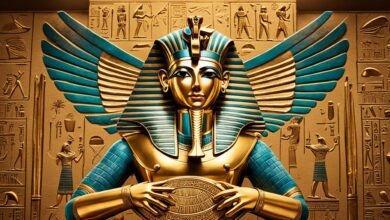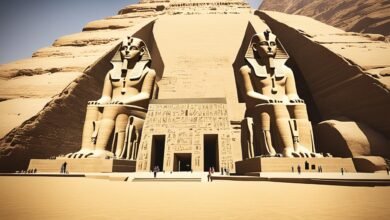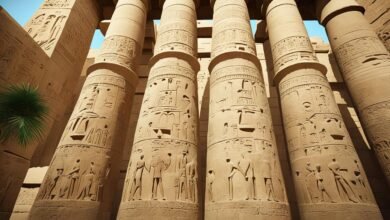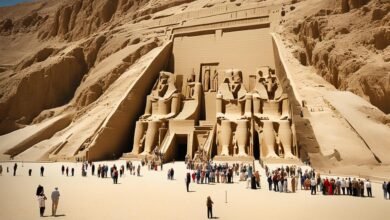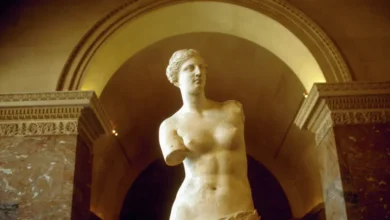Table of Contents
The Great Pyramids of Giza have stood for over 4,500 years. They still hold many riddles for historians and archaeologists. These huge structures have secrets that we still don’t fully understand. They make us ask questions like: How did the ancient Egyptians build such incredible things with basic tools? What’s hidden in the Great Pyramid’s winding chambers? And what’s the reason for the strange empty space found in this old holy place?
Come with us on a journey back in time to the pyramids of Giza. We will share stories about how they were built, why they were important in history, and what they mean to us today. Let’s explore these ancient wonders together. As we do, we aim to uncover the secrets of these incredible structures. They are some of the most amazing sights in the world.
The Historical Significance of the Pyramids of Giza
The pyramids of Giza are hugely important in history. Egyptian pharaohs built them, thinking they’d become gods after death. These pyramids are amazing structures and hold many things for the pharaohs to use in the next life. Pharaoh Khufu started building the first pyramid around 2550 B.C. It was followed by Pharaoh Khafre’s slightly smaller pyramid and the famous Sphinx. Pharaoh Menkaure then built the third pyramid, which is even smaller but has a very detailed temple inside. These structures show how smart and skilled the ancient Egyptians were.

Let’s explore why the pyramids of Giza are so significant. We will look at what makes them stand the test of time.
| Pyramid | Pharaoh | Size | Unique Features |
|---|---|---|---|
| Great Pyramid | Khufu | Staggering height of 481 feet | Constructed by over 2.3 million stone blocks |
| Pyramid of Khafre | Khafre | Slightly smaller | Accompanied by the enigmatic limestone Sphinx |
| Pyramid of Menkaure | Menkaure | Smaller yet features a more detailed interior temple |
The pyramids of Giza are still impressive today. They show the amazing knowledge of ancient Egyptians. Each pyramid was a tomb for a pharaoh. They believed in the afterlife. Today, these pyramids are a must-see for people all over the world. They help Egypt’s tourism a lot.
Note: Please make sure to include the image provided in the article, placing it in the center.
The Enduring Legacy of the Pyramids of Giza
The pyramids of Giza are seen as a top architectural feat in history. They stand as the only ancient world wonder still intact. While others have vanished with time, these pyramids showcase ancient Egyptian brilliance.
Visitors from everywhere are drawn to these monumental structures. They want to witness their grandeur and learn their stories. The pyramids are not just historic; they are a living, breathing part of Egypt’s legacy.
The scale and precision of the pyramids’ construction are awe-inspiring. The Great Pyramid of Khufu was the tallest man-made building for over 3,000 years. This shows the tremendous skill and effort of the Egyptian people.
Visiting Giza is like stepping back in time to an ancient wonder. The sheer size of the pyramids sparks admiration for their creators. These structures continue to stand as a testament to Egypt’s ancient greatness.
The Enduring Wonder of the Pyramids
The pyramids’ mystery is as intriguing as their size. From secret rooms to complex designs, they still puzzle experts. Their secrets add to their everlasting charm.
These pyramids are a symbol of Egyptian culture and intelligence. They remind us of a flourishing ancient society. It’s important to keep these wonders safe so future generations can enjoy them and uncover their mysteries.
| Pyramids of Giza | Wonders of the World | Historical Landmark |
|---|---|---|
| Symbol of ancient Egyptian civilization | Last remaining wonder of the ancient world | Enduring legacy of architectural brilliance |
| Attraction for tourists from around the globe | Awe-inspiring grandeur | Continued fascination and intrigue |
| Mysteries and unanswered questions | Preservation of cultural heritage | Engagement with ancient history |
The Construction Techniques of the Pyramids of Giza
The construction of the pyramids of Giza remains a mystery. Many believe the Egyptians used different methods to achieve this monumental feat.
They likely used wet sand under the blocks and sleds to move them. The wet sand acted as a lubricant, reducing friction and making it easier to move the stones.

Stones were moved from quarries to the pyramid sites using ramps. These ramps were made of wood and earth, creating an inclined path. This made it possible to roll or drag the stones to their needed places during construction.
Lifting the heavy stones to the top levels of the pyramids is a big question. Some think they built internal ramps or used pulleys and levers. But, we don’t know for sure how this was done.
The number of workers who built the pyramids is also debated. Herodotus thought 100,000 workers were involved. New evidence suggests it could have been as few as 20,000 workers.
| Construction Techniques | Key Features |
|---|---|
| Use of Wet Sand and Sleds | Reduced friction for easier transportation |
| Ramps | Facilitated movement of stones from quarries to construction sites |
| Lifting Methods | Speculative, with theories ranging from internal ramps to pulleys and levers |
| Number of Workers | Debated, with estimates ranging from 20,000 to 100,000 |
The exact details of how the pyramids were built are still not completely clear. Even so, their presence shows the incredible skill and creativity of the ancient Egyptian people.
The Enigmatic Interior of the Great Pyramid
The Great Pyramid of Giza’s interior is like a complex puzzle. It’s filled with rooms and paths that keep experts and archaeologists guessing. Once inside, you’ll find different rooms, each with its special meaning and size.
The King’s Chamber is right in the middle and stands out. It might have been the place where Pharaoh Khufu’s coffin was kept. This room shows how skilled the ancient Egyptians were at building big, mysterious structures.
Compared to the King’s Chamber, the Queen’s Chamber is simpler. It sits above and has a unique roof. We’re not exactly sure what it was used for, but it possibly had a ceremony or meaning for the pyramid’s design.
The pyramid is still hiding secrets, with more rooms and paths to explore. One new finding is the ScanPyramids Big Void. This is a large, empty space found with a special technology, which has made people wonder what it was for.
Look at the table below to see the main parts of the Great Pyramid’s interior:
| Chamber | Description |
|---|---|
| King’s Chamber | The grandest and most significant chamber, believed to hold the sarcophagus of Pharaoh Khufu. |
| Queen’s Chamber | A smaller chamber positioned above the King’s Chamber, offering a more modest setting. |
| Hidden Passageways | Obscure corridors and tunnels that lead to unknown areas within the pyramid. |
| ScanPyramids Big Void | A large cavity detected using muon radiography, raising questions about its purpose and significance. |
| Additional Chambers | Various other chambers of different sizes and purposes, awaiting further exploration and study. |
Archaeologists and researchers are hard at work solving the pyramid’s mysteries. They use science to understand the hidden parts and secrets. They hope to finally answer questions that have been asked for many years.
Technological Advancements in Pyramid Research
Technological advancements are key in unraveling the pyramids’ mysteries. Researchers now use state-of-the-art tools. They delve deep into ancient structures, discovering new secrets. One major advancement is muon radiography.
Muon radiography uses particle physics. Muons are tiny particles that can go through solid objects, like pyramid stones. By observing muons traveling through pyramids, researchers can map their insides.
Muon radiography has had big wins in pyramid studies. In 2017, it led to a major find – the ScanPyramids Big Void. This hidden space in the Great Pyramid of Giza was found by analyzing muon data.
| Technological Advancements in Pyramid Research | Benefits |
|---|---|
| Muon Radiography | Provides insights into the internal structure and layout of the pyramids. |
| Laser Scanning | Allows for precise 3D modeling of the pyramids and their intricate features. |
| Ground-penetrating Radar | Helps identify hidden chambers and passageways beneath the surface. |
| Thermal Imaging | Aids in identifying temperature variations that may indicate hidden chambers or structural anomalies. |
Besides muon radiography, other tech also aids pyramid research. Laser scanning makes detailed 3D models of the pyramids. It showcases the beauty of these ancient wonders. Ground-penetrating radar finds hidden spaces underground. Thermal imaging spots spots with different temperatures, showing possible secret chambers.
These technologies have enhanced our view of the pyramids. They give us insights into how they were built and their purposes. Research and tech advancements will bring more discoveries in time.
Now, we’ll look into the mysteries and dig sites around the Giza pyramids.
Unanswered Questions and Ongoing Excavations
For many years, experts have worked on Egypt’s pyramids but challenges persist. There’s still mystery around hidden chambers and the structure’s complex design. Also, where their builders got their advanced knowledge from is still unknown.
But thanks to new technology and ongoing digs, there’s hope. Archaeologists and scientists work hard to uncover the pyramids’ secrets. They aim to reveal the historical and cultural importance of these wonders through their work.
Uncovering Hidden Chambers and Passageways
The hidden parts of Giza’s pyramids, like chambers and halls, spark interest. Despite centuries of study, much remains to be found in these ancient structures. Excavations hope to open up these hidden spaces.
With new tech, researchers aim to learn more. They slowly remove the layers of history to glimpse the pyramids’ past. These efforts may finally shed light on why these hidden areas were built.
Advancements in Technology
Technology has changed how researchers look at the pyramids. New tools let them examine the structures without damage. This includes radar and 3D scanning, which are very helpful.
Yet, muon radiography is a significant step forward. It can map the pyramids’ insides by seeing particles pass through. Already, it’s found hidden spaces that were previously unknown.
Continued Quest for Answers
The exploration of the pyramids is a journey that keeps people curious. Many questions about these ancient buildings drive more research.
Archaeologists and scientists are committed to solving these mysteries. Their hard work is focused on finding answers within the pyramids’ stones. They hope to reveal the full story of these famous sites.
| Unanswered Questions | Ongoing Excavations |
|---|---|
| The purpose of hidden chambers | Excavating to Find Insights |
| The significance of the structure inside | Technological Advancements |
| The source of the advanced building knowledge | Quest for Further Knowledge |
Despite the ongoing mysteries, we’re getting closer to the truth. By combining new tools with classic methods, we make progress. The pyramids are a true symbol of ancient skill and intrigue. They continue to stand as a source of endless fascination for everyone.
The Cultural Significance of the Pyramids of Giza
The pyramids of Giza are more than just ancient structures. They are symbols of an advanced Egyptian society. This society understood complex math, engineering, and architecture.
They showcase the ancient Egyptian people’s brilliance. Each was carefully designed for a pharaoh’s burial. This showed the pharaoh’s journey into the afterlife.
They also demonstrated a pharaoh’s divine rule. This meant they had mastery over both life and death. The structures highlight the grandness of these rulers and Egypt’s deep beliefs.
Today, the pyramids remain an essential part of Egypt’s identity. They are a huge draw for tourists worldwide. They stand as a living piece of Egypt’s history, showcasing its cultural heritage.
But the pyramids mean more than their past. They’ve inspired endless art, books, and movies. They fuel curiosity and stand as a symbol of what humankind can achieve. This captivates everyone, from experts to visitors.
Image:

The Tourism Impact of the Pyramids of Giza
The pyramids of Giza are very important historically and culturally, drawing visitors worldwide. They are key in Egypt’s tourism, attracting millions each year. These pyramids are famous, and listed as a UNESCO World Heritage.
The ancient sites in Egypt, including the pyramids, leave visitors amazed and eager to learn. You can see the impressive architecture, learn about the pharaohs’ history, and see the structures’ grandeur up close.
Visiting the pyramids is unforgettable. It’s awe-inspiring to stand by the Great Pyramid or explore its hidden chambers. These ancient wonders keep inspiring and sparking curiosity about ancient Egypt.
Besides their historical importance, the pyramids are vital for Egypt’s economy. Tourism creates jobs and supports local life. By going to the pyramids, you both learn and help preserve these treasures.
When planning an Egypt trip, make sure to see the pyramids of Giza. They appeal to anyone interested in history, adventure, or culture. Come and witness the timeless fascination of the Giza pyramids yourself.
Reasons to Visit the Pyramids of Giza
| 1. Historical Significance | 2. Architectural Marvels | 3. Cultural Immersion |
|---|---|---|
| Explore the ancient Egyptian civilization | Witness the grandeur of the pyramid structures | Immerse yourself in the rich history and traditions |
| Uncover the secrets of the pharaohs | Marvel at the precision and ingenuity of the construction | Experience the vibrant Egyptian culture |
| Learn about ancient burial practices | Discover the hidden chambers and passageways | Interact with local communities and artisans |
| Appreciate the historical impact of the pyramids | Capture stunning photographs and memories | Sample delicious Egyptian cuisine and hospitality |
Preserving and Protecting the Pyramids of Giza
Keeping the pyramids of Giza in good shape is key for future generations. They are more than just old buildings. They’re windows to ancient Egypt’s culture. The Egyptian government works with groups worldwide to take care of these wonders.
Steps are taken to protect the pyramids from too much tourism and harm. There’s controlled access, regular checks, and continuous study. This work helps keep the pyramids safe while still welcoming visitors.
Never-ending research helps us know how to save the pyramids. With high-tech tools like laser scans and 3D models, experts find ways to keep them from falling apart. They make digital copies to test different protection methods.
Working with experts from around the world boosts these protection efforts. It means sharing what works best and getting help from specialists. This teamwork brings together the latest in saving ancient treasures.
Conservation Strategies and Initiatives
Conserving the pyramids requires many skills. It takes teamwork and new ideas to deal with these old structures. Important work includes:
- Experts check the pyramids often and fix them when needed, keeping them safe for all.
- They fight against pests that can destroy the pyramids with special plans.
- Trying to reduce harm to nature from visitors by managing waste and energy better.
- They involve local people in taking care of the pyramids. This includes teaching them about the pyramids’ cultural worth and asking for responsible tourism.
Using these steps and more, we can keep the pyramids around for later generations. This work makes sure Egypt’s ancient culture stays alive, teaching and inspiring us all.
The Eternal Wonder of the Pyramids of Giza
The pyramids of Giza are a symbol of ancient brilliance and hard work. They still amaze and inspire us today. These wonders were built by the ancient Egyptians, showing their amazing skills.
People around the world are fascinated by the pyramids. They are not just old buildings; they are extraordinary monuments. These structures make us wonder about our history and what we know.
The construction of the pyramids shows the Egyptians’ great engineering. Their precise design and massive size still impress us. They are a sign of what people can do, even in distant times.
